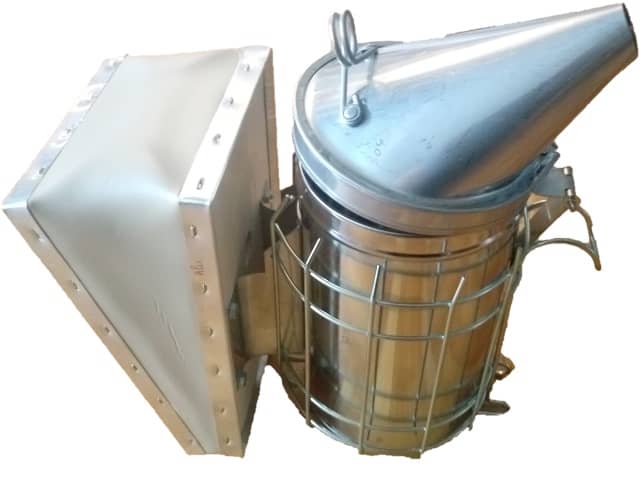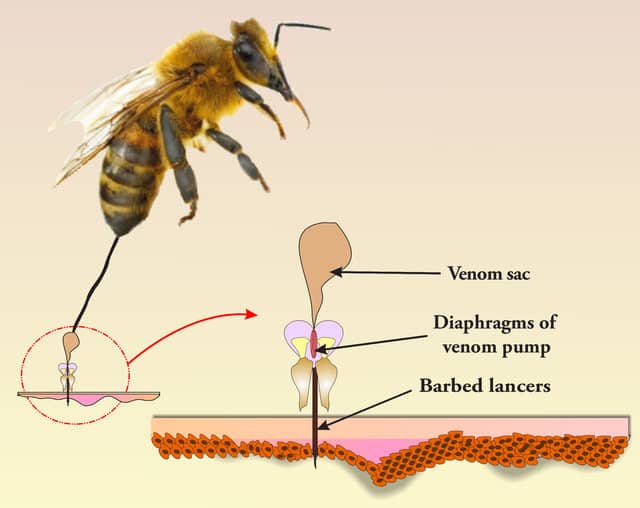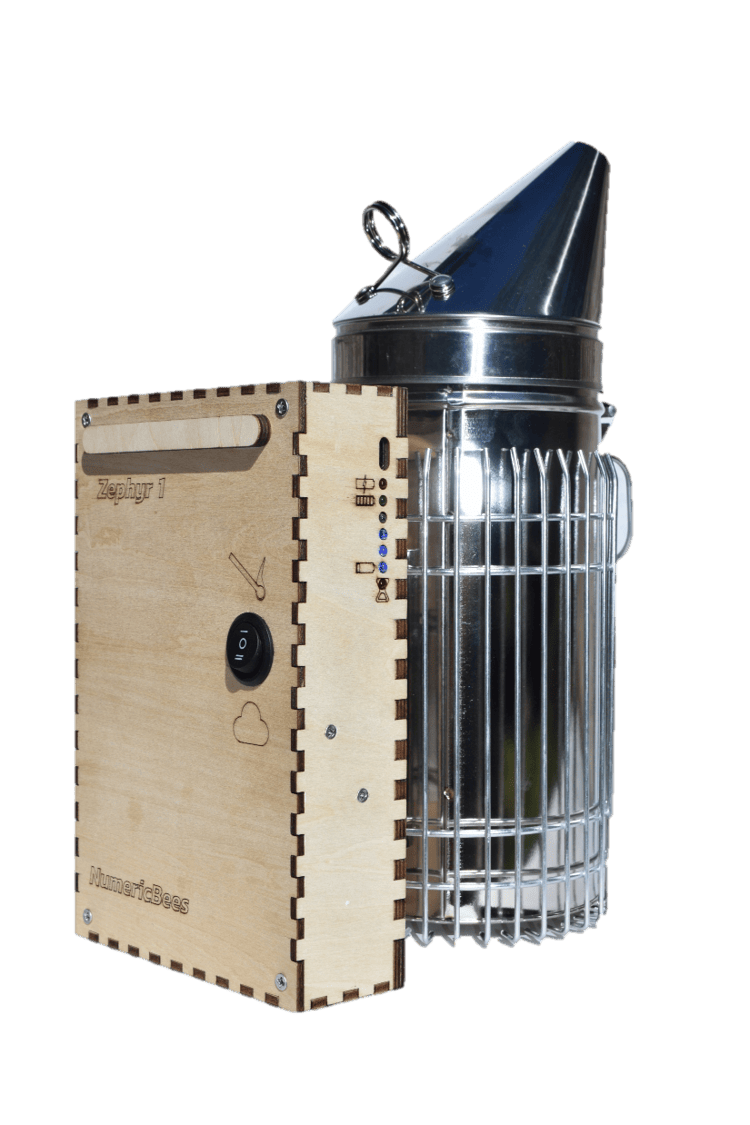Beekeeping: the bee smoker
Published on 2 October 2022Summary: In this article we explain the origin of the bee smoker, how to light your smoker? What fuel to use in a bee smoker? How does the beekeeper use his smoker and when he does not use it?

Origin of the need for a smoker
The honey bee, Apis mellifera mellifera, is a wild insect that is "cultivated1" and not bred. Domestic comes from the Latin "domus", the house, near which the beekeeper sets up his hive. The bee is equipped with a stinger and a venom gland.
 Credit: Daniel Elieh-Ali-Komi
Credit: Daniel Elieh-Ali-Komi
She can only use it to sting once. The stinger is equipped with barbs which, when planted in the dermis of its enemy, prevent the bee from removing it. The venom gland and its muscles as well as the stinger remain attached to the dermis. The muscles continue to inject the venom into the target. The bee, deprived of its defensive appendage, soon perishes. In doing so, it offers itself as a sacrifice for the survival of the colony.
Credit: Biology Open Journal
However, this is not the only use the bee can make of it. In fact, by straightening its abdomen, the bee can extract its stinger and express a drop of venom at the end of it. It then flaps its wings to spray the liquid. In doing so, it generates an alarm signal for its fellow beetles, which are quick to do the same and pursue the enemy. Once stung, the target is marked by the smell of the venom, which arouses the aggressiveness of the bees, which come to sting in the same place.
Although beekeeping is not new - earthen hives dating back to 900BC have been found2 - the term beekeeping has only existed since 18453. Before that, in prehistoric times, man was a honey gatherer. To facilitate his gathering and to scare away the bees that came between him and his booty, man had the idea of smoking their habitat. The man observed that this smoke caused the bees to flee, and they deserted the nest4. This practice continued, and the bellows smoker was created by Moses QUINBY around 1870 in the USA5. It was discovered that the hairs on the legs of bees can detect very small variations in the content of CO2, which is one of the constituents of smoke along with water vapour.
Science shows that the likelihood of the bee producing a drop of venom at the tip of the stinger to create an alarm is reduced by the presence of smoke. The fuel used is also important.10 Research has shown that eight of the components of the venom and one component of the mandibular glands trigger an aggressive reaction in bees.11
The smoke that is propelled by the bellows serves to mask the smell of the bees' warning venom. The alarm signal is masked by the smoke and the alarm bee cannot recruit fighters. The smoker is therefore the beekeeper's indispensable tool to the extent that one cannot be a beekeeper without it.
The bee smoker
The smoker created by Moses QUINBY was improved by T.F. BINGHAM, L.C. ROOT, son-in-law of Moses QUINBY, A.G. HILL, G.W. BRODBECK, and finally H. ROOT in 1905 (patent US7989826) finalized the bee smoker as we know it today. Since 19507 various inventors have replaced the bellows with an electric fan. Despite the undeniable advantage of the electric smoker over the mechanical bellows, no device has managed to seduce beekeepers. However, the mechanical bellows is difficult to operate, especially during the lighting phase, which requires frequent and long pumping. Moreover, the bellows are the first cause of failure of the smoker since they are pierced, especially at the lower folds.
In Germany another tool is sometimes used, a kind of large tobacco pipe. The beekeeper activates a combustion and produces smoke by blowing into a pipe. The beekeeper blows into a pipe and brings his head closer to the bees.
How it works
The smoker consists of two parts. A combustion chamber and a ventilation activator, mechanical bellows or electric fan. In the combustion chamber, a fuel containing a small proportion of water is set alight. Combustion has two effects: the expansion of the gases - as in an internal combustion engine, the gases increase in volume due to the heat - this is what causes the fire to be drawn, and the production of water vapour, the smoke. The fuel must therefore have two qualities: it must ignite fairly easily and it must produce steam. If the air inlet and outlet holes are correctly dimensioned, and the fuel is adequate, combustion is self-sustaining throughout the beekeeper's working day. On the market you will find stainless steel smokers that are correctly dimensioned and others that are less so. In particular, there are appliances with an air inlet hole that is too small and that expel air from the bellows. These appliances can be identified by the fact that they switch themselves off, but also by the fact that there are traces of bistre all around the bellows hole.
Smoker fuel
The Romans used dried animal excrement, but this material is no longer available. Burlap bags which were used to transport agricultural produce in the past have also disappeared. Burlap was an excellent fuel containing residual moisture. It was easy to light and produced a nice smoke. Today we can find fuels in nature: hay, straw, pine cones, lichens, pine needles, crop waste - lavender or other, and others that can be bought in the shop: wood pellets, alfalfa, lavender. Cardboard, paper and egg cartons can be used to complete the fuel mix, particularly to facilitate the lighting stage.
Personally I use a little hay and a match to light the smoker and I fill it with a 50/50 mixture of smoker or stove pellets and alfalfa pellets. The electric fan on my Zephyr smoker does the rest. No need for pumping or an expensive soldering lamp to start the device. As Jean RIONDET says in his courses, if the beekeeper doesn't cough, the smoker is badly lit.
How to light a smoker?
To light the smoker correctly you need to start with a hot fire, which will create red embers, which will be used to maintain the combustion of a more humid fuel that will produce water vapour and therefore thick smoke. This can be done with hay, straw, cardboard, paper, pine needles. Do not rush to load the firebox. Ignite your cardboard, say, so that it makes flames and pump on the bellows so that red embers appear. Then load a small amount of fuel, and keep pumping vigorously for a few minutes - or turn on the blower - until this first load starts to burn and produces a very thick white smoke. Those who have a Zephyr electric blower can fully charge their device and shut it down, then suit up while their device lights itself. Once your first load starts to produce smoke, load your device to within two centimetres of the top - or less if you only have one or two hives. Then block your fuel with a pad of fresh, green grass. The purpose of this pad is threefold: to prevent the escape of burning fuel from the blowpipe, to condense the tars and hold them, and to allow a whiter, denser smoke. This will prevent red embers from spilling into your hives or onto the ground, and will produce a nice thick smoke.
Using the smoker in the apiary
Avoid smoking at the entrance to the hive. This will only disorganise the colony and cause the queen to flee to the top of the frames, making her search long or fruitless. Protecting your queen in a clip during your visit will prevent her inadvertent loss and the orphaning of your colony. Do not smoke until you have observed the bees on the top of the frames. Are they calm, numerous, do they occupy all the frames? You can only observe this if you have refrained from banging the roof and after carefully removing the frame cover. The absence of vibrations will guarantee you the calm of the bees. They have no ears but have six legs to pick up vibrations. This is the time to be gentle. Observe. Normally you should not see a bee with its abdomen raised and pointing at you, a sign of stings in the very near future. To start working, lightly smoke the head of the frames, the bees should be hiding in the inter-frame banks. With a Zephyr automatic smoker you only have to tilt the smoker and sweep the surface of the hive. Put the device down and the smoke production will stop automatically.

Start your visit by walking from one side to the other. A Hoffman spaced frame hive will make your job much easier, you will no longer have to extract the frame heads vertically from the racks full of propolis. All you have to do is slide the frames onto the slides. This will limit the vibrations, the rubbing of bees on each other, and the trouble that goes with it. Your visits will be smoother and faster.
Only smoke if the bees start to fly, and come and talk to you in the hollow of the ear. This type of bee is often aggressive and changing your lineage to a gentler one will make you enjoy your passion even more.
When not to use the smoker?
Not using the smoker does not mean that you should not have one properly lit near you. It is your best protection against an attack.
That said, the smoker should be totally banned during the harvest, and in particular never be used to smoke hive frames full of honey. Never empty the supers of bees with smoke. On the one hand because you destroy the taste quality of your honey, and on the other hand because there are much easier methods for harvesting supers that are completely empty of bees. You need: a hive with empty frames, an extra board - hollow on each side8 - with a beehive remover, and 24 hours of patience. Place the hive top on the ground with the hollow side facing you. Do not remove the frame cover. Take off the brood chamber to be harvested, lay it across the top of the hive on the ground. Place your empty chamber on the body. Place the bee catcher tray - bee catcher down on the side of the hive you have just placed and in which the overflowing bees will settle. Place the beehive full of honey and its frame cover on top of the beehive tray. After 24 hours your honey chamber should be completely empty of bees, take it and place it in an inverted roof and place it on top of another roof, so that the bees do not venture in. If the bees are still there then there is brood in the hive you were planning to harvest9. This cannot be done. Return the hive to its previous state and wait for the births to finish.
-
https://journals.openedition.org/tc/268 Just like the oyster - oyster farming - or the mussel - shellfish farming. ↩
-
https://lejournal.cnrs.fr/articles/des-abeilles-et-des-hommes ↩
-
https://journals.openedition.org/tc/268 already quoted. ↩
-
This method is used today to create what is called a naked swarm by scaring away the queen and some of the bees in another hive superimposed on the first one by copious and prolonged smoking, associated with strong and repeated vibrations. ↩
-
https://www.beeculture.com/moses-quinby/ and https://en.wikipedia.org/wiki/Moses_Quinby ↩
-
https://worldwide.espacenet.com/patent/search/family/009571745/publication/FR1013556A?q=FR1013556 ↩
-
The fact that it is hollow on each side will help to contain anarchic constructions full of honey under the superstructure frames, and will prevent the honey from flowing out of the hive. ↩
-
As a reminder, when you lay a supers at the beginning of the season, there should be room to lay eggs in the body. If necessary, remove a frame of reserves and give an embossed wax to build on. Place embossed frames only in the centre of your chamber. If there are no cells in the brood chamber, no eggs can be laid. ↩
-
https://www.ars.usda.gov/ARSUserFiles/60500500/PDFFiles/101-200/107-Collins--Bioassay%20of%20Compounds%20Derived.pdf ↩